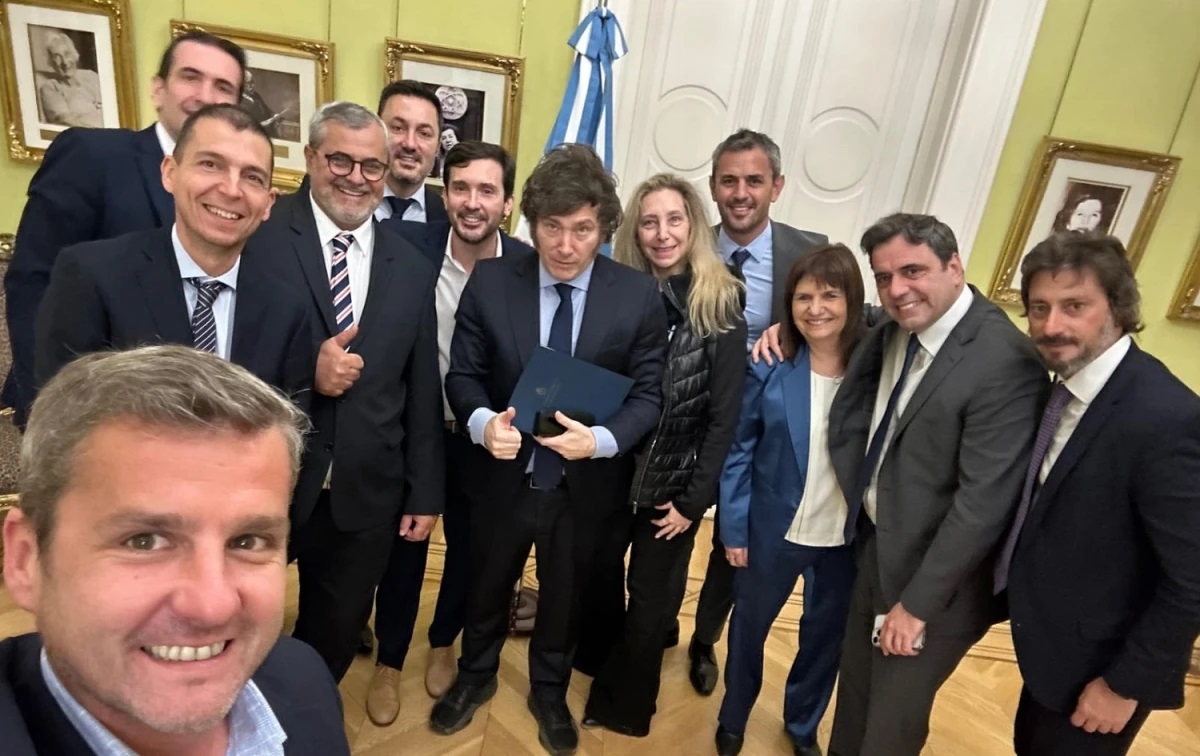
Mariano Campero greets; makes gestures; smiles. He stands for several minutes at the door of the building next to the Chamber of Deputies. He feels like a kind of collapse of the political caste. It is Thursday afternoon: 24 hours have passed since the pathetic shouting he rehearsed in the lower house to defend the presidential veto of the increase in pensions. deputy from Tucumán enjoys his ephemeral and questionable fame. He represents an aberrant second-rate character in the unfathomable crisis of political representation that ravages the country.
Campero’s pathos exposes the shortcomings of the government’s political structure. It shows the fragility of an officialism that lacks its own troops and – in need of avoiding shipwrecks – runs to secure temporary allies. method is that of the caste: sitting on the edge of a table, Milei negotiates and offers; she gives herself over to a give and take which confirms its belonging to that opaque and murky sphere. The method finds its greatest limit in political fragmentation: in Argentina, with its divided parties, there are too many fractions with which to make pacts.
The exhausting process confirms the structural weakness of the Mileísta project. The government does not attract allies: buy willsIt is not strengthened ideologically: it is nourished, through its wallet, by scraps of other people’s disintegration. It operates without distinctions: radicals, macrists and peronists They enter into the orbit of that which, being integrated, can add governability.
He official handicap lies in that fragmentation; in the extended opposition crisisborn out of recent government failures. Social support for the president is increasingly anchored in hope, a fragile passion that can crumble in the face of the cruel harshness of reality.
The fragility of the method explains how the questionable “victory” obtained in the House of Representatives vanished in a few hours. The Senate dealt two defeats in one night. In that 2×1, DNU N°656/24, which granted $100,000 in reserved funds to the SIDE, fell. The failure has the air of a novelty: it had never happened in history. Hours before, the Upper House had staged another setback for the Government: the approval of the University Financing Law. The president has already announced a new veto.
The The response to this measure will be in the streetsHistory will surely repeat the powerful images of the April 23rd: hundreds of thousands flooding avenues and squares throughout the country. That fight, however, requires preparation. It requires the Democratic organization of students, teachers and non-teaching staff in each school, faculty and universityThere, in that force that can emerge from below, lies the guarantee of continuity. The alternative to the endless and inconclusive disputes between university authorities and the adjusting government.
A crisis of the repressive apparatus
This Friday morning, Eduardo Feinmann apologized to Patricia Bullrich: “I apologize a thousand times if I ever said anything that could have affected you.” The operator-journalist had “only” asked for her to be fired from the Government.
The Minister of Security is currently passing through distress zone. Tainted by the scandalous operation that attempted to cover up police repression against a 10-year-old girlBullrich must choose whose head will roll. It will not be hers, clearly. The official occupies too relevant a place in the official scheme to be ejected.
The media operation deployed by the government finds its deepest explanation in the illegitimate nature of repression unleashed on Wednesday. Beaten and tear-gassed, Fabrizia appears as a symbol of state violence deployed against the weakest. Neither the “ordering of the streets” nor the “zero deficit” add consensus to hit retirees.
Esa Illegitimacy threatens to grow; expand. It feeds on the economic tensions that plague the daily lives of the working majority. Of that hell of deprivation that is staged in every visit to the supermarket. Of that permanent renunciation of meat, milk, bread or fruit. Of that intense bitterness that is triggered by looking at the electricity, water or gas bills.
The Mileísta “model” is plagued by multiple flaws: the lack of dollars; the growing debt; the lack of investments from the business community that offers political backing to the adjustment plan. Increasing these tensions, in the last few hours it became clear that inflation is far from having been “destroyed.”
In a scenario of permanent recessionlos self-praise of Mercy They seem like an insult to millions. The president still believes too much in his own “prophecies.” He holds on to the conviction that “the biggest adjustment in the world” was a popular desire that overcame any economic rationality. Reality is beginning to show him his error.
Who fights and who is erased
Las Wednesday’s pictures They are also of combat readiness. Retirees symbolize the active resistance to a fierce adjustment. They begin to condense the hatred of millions, who reject the economic, social and cultural program of the Mileísta right. A chasm separates them from the immense majority of the Peronist union arch, more willing to betray than to set foot on the street.
This week brought another novelty: Andrés Rodríguez, millionaire horse owner who acts as a union leader at UPCN, played the influencer. He released a video where, tangling words, he tried to explain that the CGT no He withdrew from the fight of retirees. Convoluting itself, it presented the decision not to mobilize as a “tactic.” The “commitment” of this CGT faction to the retirees and their demands amounts to a harmless press release.
Another current within the CGT leadership Yes, it did mobilize. It did so with a moderation that the Government could praise. Once again, it chose not to call for a strike that would guarantee mass participation in the streets. Truckers, the union that leads Hugo and Pablo Moyanorepeated almost exactly what had happened on June 12: he marched to the corner of Moreno and Entre Ríos, three blocks from Congress. From there he left. He never made it to the general mobilization.
The little or no confrontation of the bureaucratic union arc It is not explained only by the mechanics of pure betrayal. It is also due to the deep crisis that Peronism as a whole is going throughIn permanent decline since the electoral defeat, while bleeding to death in a myriad of cross-accusations, it drags its feet on the road to 2025.
In that sea of tensions, Cristina Kirchner is forced into the “mud” of politics; to enter the fierce fight for a place in the chaotic attempt to reorganize Peronism. This Friday she did it in Merlo, returning to the worn-out format of master classes. Antagonizing Milei, the former vice president is betting on a centrality that will allow her to improve her conditions for the internal conflict that is inevitably coming. This battle is also being fought in the Province of Buenos Aires, where Kicillof is administering his own version of the adjustment. To do so, he has the support of the bureaucratic leaderships of state unions that, as reported in LetraP a few days ago, offered their collaboration to “govern in this context.”
Behind this universe of internal affairs inhabits a common social and political strategy: bet on Milei’s wear and tear prepare for the electoral return. Whether in 2027 or whenever conditions dictate it. This global orientation is what explains why Peronism, in its various factions, is also engaged in frenetic collusion with the Mileísta administration and the employers’ opposition.
Esa The structural crisis of Peronism makes it urgent to build a new political force of the working class. A force that deploys and fights a anti-capitalist and socialist agendathe only alternative path to the infinite decadence imposed by big business, the true boss of Milei and the political forces of the employers. Let him work for the democratic organizationfrom below, in every workplace and place of study. That bets on the emergence of class struggle as a factor to confront and defeat the adjustment mechanism of capital.
To this task of construction he devotes forces, will and resources of the PTS-Left Front. This fight is being waged on all fronts. This Wednesday, it happened both inside and outside the Congress hall; with its national deputies, its representatives and its militants facing the presidential veto.
Aerolíneas Argentinas: a key battle
Eternal provocateur, this Thursday night Federico Sturzenegger announced the regulation of article 182 of DNU 70/23which attempts to impose essentiality in passenger transport. In political terms, the decision implies confronting powerful unions. It is a risky bet, putting the Government in an offensive position that is not consistent with its institutional weakness and the fragilities of its political structure. It does, however, address the to the global logic of the millenary project: to strike hard in order to alter the balance of power in the interests of the most concentrated economic power.
The social strength of aeronautical workers began to be evident this Friday, in the emptiness and paralysis that marked the scene in Ezeiza, Aeroparque and many other places in the country.
In this scenario, the struggle of the workers of Aerolíneas Argentinas takes on a political character. It is presented as a fight of the entire working class. Responding to and defeating the attack is an obligation of the CGT and all union leaders.. Not doing so is equivalent to continuing down the path of betrayal that complicitly facilitates the savage adjustment of the far right.
Source: www.laizquierdadiario.com

